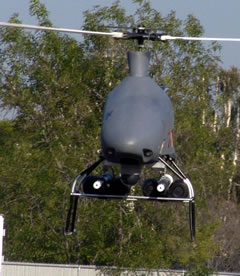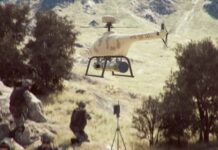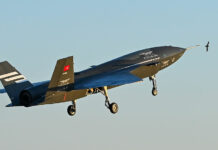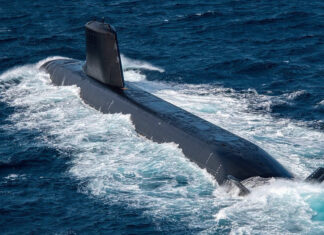Developers of VTOL UAVS are looking beyond 2.75″ rockets, designing their vertiflight platforms as flying remotely controlled weapon stations. The concept is to keep the warfighter out of harms way and let the machines take all the risk. Ultimately, such system could provide expeditionary forces and front line warfighter with a portable compact attack helicopter. The unmanned helicopter will provide the ability to approach the target at high speed, from any direction and deliver a contained lethal salvo into the specific target, regardless of elevation or how well it is defended from ground approach. This is especially important as today’s conflicts waged at urban settings.
An example of such system is the Tactical Aerospace Group (TAG) is introducing recoilless weapons package for their aircraft as part of ongoing UCAV weaponization programs, integrating a new recoilless technology developed by Recoilless Technologies International of Australia. Initially, the new mounts will be built to carry 7.62mm machine guns, but future versions will be designed for different calibers, including grenade launchers.
 Another weapon recently demonstrated in live firing is the Metal-Storm 40mm weapon system which flew on the DP-5X prototype Vertical Take Off and Landing (VTOL) Unmanned Aerial Vehicle last autumn (2006). This weapon is optimized for UAV applications, by its inherent high firepower to weight ratio resulting in a lighter weapon with greater firepower, compared to other weapons. During recent tests the vehicle fired the lightweight electronic weapon from hovering position and through forward speed flights, performing “strafing” runs. The Metal Storm technology offers several advantages for arming UAVs, specifically for the smaller UAVs where payload weights and weapon size and shape are critical design factors, impacting on the mission endurance and payload capacity remaining for mission critical avionics. The electronic operation and low recoil generated by the Metal Storm launcher offers inherent weight advantages.
Another weapon recently demonstrated in live firing is the Metal-Storm 40mm weapon system which flew on the DP-5X prototype Vertical Take Off and Landing (VTOL) Unmanned Aerial Vehicle last autumn (2006). This weapon is optimized for UAV applications, by its inherent high firepower to weight ratio resulting in a lighter weapon with greater firepower, compared to other weapons. During recent tests the vehicle fired the lightweight electronic weapon from hovering position and through forward speed flights, performing “strafing” runs. The Metal Storm technology offers several advantages for arming UAVs, specifically for the smaller UAVs where payload weights and weapon size and shape are critical design factors, impacting on the mission endurance and payload capacity remaining for mission critical avionics. The electronic operation and low recoil generated by the Metal Storm launcher offers inherent weight advantages.
Northrop Grumman is developing the Fire Scout (MQ-8B) as a Vertical Takeoff UAV (VTUAV), operable on land or from surface vessels. The US Navy is acquiring the MQ-8B Fire Scout UAV to fulfill the service’s requirement for a tactical UAV capable of operating in the shipboard environment. With vehicle endurance greater than six hours, Fire Scout will be capable of continuous operations providing coverage over 110 nautical miles from the launch site. A baseline payload that includes electro-optical/infrared sensors and a laser designator, enables Fire Scout to perform different roles. These include finding tactical targets, tracking and designating these accurately, providing targeting data to strike platforms and perform battle damage assessment. FireScout was also selected for the US Army FCS Class IV UAV, offering future units of action a flexible, weaponized ISR and attack platform.
Read additional parts of this article:
- Smart Weapons for UAVs
- Weaponized UAVs
- Smart Weapons for UAVs
- Evolution of UAV Employed Missiles
- Lightweight Weapons for Autonomous Platforms
- Gravity Dropped Munitions for UAVs
- Targeting at the pixel
- Loitering Autonomous Weapons
- Grouping in Constellations
- Empowered by the Swarm
- Weaponizing Unmanned Combat Helicopters

















